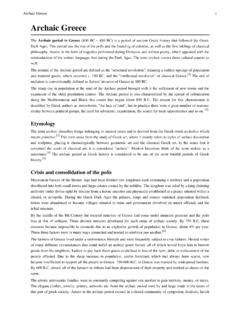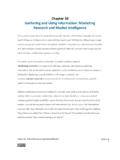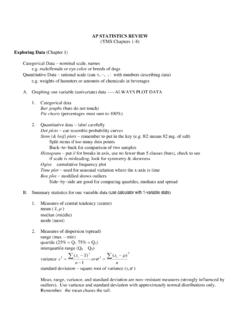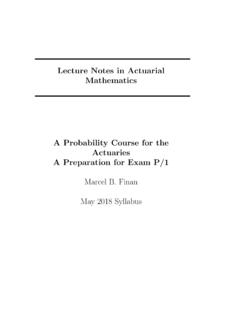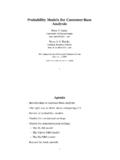Transcription of Institutional Review Board Guidebook - Saylor …
1 Institutional Review Board Guidebook * CHAPTER III * BASIC IRB Review A. RISK/BENEFIT ANALYSIS INTRODUCTION Risks to research subjects posed by participation in research should be justified by the anticipated benefits to the subjects or society. This requirement is clearly stated in all codes of research ethics, and is central to the federal regulations. One of the major responsibilities of the IRB, therefore, is to assess the risks and benefits of proposed research. DEFINITIONS Benefit: A valued or desired outcome; an advantage. Minimal Risk: A risk is minimal where the probability and magnitude of harm or discomfort anticipated in the proposed research are not greater, in and of themselves, than those ordinarily encountered in daily life or during the performance of routine physical or psychological examinations or tests [Federal Policy (i)].
2 For example, the risk of drawing a small amount of blood from a healthy individual for research purposes is no greater than the risk of doing so as part of routine physical examination. The definition of minimal risk for research involving prisoners differs somewhat from that given for noninstitutionalized adults. [See 45 CFR 303(d) and Guidebook Chapter 6, Section E, "Prisoners."] Risk: The probability of harm or injury (physical, psychological, social, or economic) occurring as a result of participation in a research study. Both the probability and magnitude of possible harm may vary from minimal to significant.
3 Federal regulations define only "minimal risk." OVERVIEW There are two sources of confusion in the assessment of risks and benefits. One arises from the language employed in the discussion: "Risk" is a word expressing probabilities; "benefits" is a word expressing a fact or state of affairs. It is more accurate to speak as if both were in the realm of probability: , risks and expected or anticipated benefits. Another confusion may arise because "risks" can refer to two quite different things: (1) those chances that specific individuals are willing to undertake for some desired goal; or (2) the conditions that make a situation dangerous per se.
4 The IRB is responsible for evaluating risk only in the second sense. It must then judge whether the anticipated benefit, either of new knowledge or of improved health for the research subjects, justifies inviting any person to undertake the risks. The IRB should disapprove research in which the risks are judged unreasonable in relation to the anticipated benefits. [See also Guidebook Chapter 5, Section A, "Overview: Social Policy Experimentation."] IRB CONSIDERATIONS The IRB's assessment of risks and anticipated benefits involves a series of steps. The IRB must: (1) identify the risks associated with the research, as distinguished from the risks of therapies the subjects would receive even if not participating in research; (2) determine that the risks will be minimized to the extent possible [see Guidebook Chapter 3, Section A, "Risk/Benefit Analysis," and Chapter 3, Section E, "Monitoring and Observation"]; (3) identify the probable benefits to be derived from the research; (4) determine that the risks are reasonable in relation to be benefits to subjects, if any, and the importance of the knowledge to be gained.
5 (5) assure that potential subjects will be provided with an accurate and fair description of the risks or discomforts and the anticipated benefits [see Guidebook Chapter 3, Section B, "Informed Consent"]; and (6) determine intervals of periodic Review , and, where appropriate, determine that adequate provisions are in place for monitoring the data collected [see Guidebook Chapter 3, Section E, "Monitoring and Observation," and Chapter 3, Section H, "Continuing Review "]. In addition, IRBs should determine the adequacy of the provisions to protect the privacy of subjects and to maintain the confidentiality of the data [see Guidebook Chapter 3, Section D, "Privacy and Confidentiality"], and, where the subjects are likely to be members of a vulnerable population ( , mentally disabled), determine that appropriate additional safeguards are in place to protect the rights and welfare of these subjects.
6 [See Guidebook Chapter 6, "Special Classes of Subjects."] Research to which DHHS regulations apply that involves fetuses or pregnant women, prisoners, or children is governed by special provisions [45 CFR 46 Subpart B, 45 CFR 46 Subpart C, and 45 CFR 46 Subpart D, respectively]. [See also, Guidebook Chapter 6, "Special Classes of Subjects."] Identification and Assessment of Risks. In the process of determining what constitutes a risk, only those risks that may result from the research, as distinguished from those associated with therapies subjects would undergo even if not participating in research, should be considered.
7 For example, if the research is designed to measure the behavioral results of physical interventions performed for therapeutic reasons ( , effects on memory of brain surgery performed for the relief of epilepsy), then only the risks presented by the memory tests should be considered when the IRB performs its risk/benefit analysis. It is possible for the risks of the research to be minimal even when the therapeutic procedure presents more than minimal risk. IRBs should recognize, however, that distinguishing therapeutic from research activities can sometimes require very fine line drawing. Before eliminating an activity from consideration in its risk/benefit analysis, the IRB should be certain that the activity truly constitutes therapy and not research.
8 It is important to recognize that the potential risks faced by research subjects may be posed by design features employed to assure valid results as well as by the particular interventions or maneuvers that may be performed in the course of the research. Subjects participating in a study whose research design involves random assignment to treatment groups face the chance that they may not receive the treatment that turns out to be more efficacious. Subjects participating in a double-masked study take the risk that the information necessary for individual treatment might not be available to the proper persons when needed.
9 In behavioral, social, and some biomedical research, the methods for gathering information may pose the added risk of invasion of privacy and possible violations of confidentiality. Many risks of research are the risks inherent in the methodologies of gathering and analyzing data, although the more obvious risks may be those posed by particular interventions and procedures performed during the course of research. A final potential risk to subjects is the possible long-range effect of applying the knowledge gained through research. For example, information gained about associative memory may enable advertising companies to develop new techniques for encouraging arguably harmful consumer behaviors; associations between race or gender and intelligence may have profound effects on public policy.
10 The regulations specifically provide, however, that IRBs should not consider such effects "as among those research risks that fall within the purview of its responsibility" [Federal Policy ]. The risks to which research subjects may be exposed have been classified as physical, psychological, social, and economic [Levine (1986), p. 42]. Physical Harms. Medical research often involves exposure to minor pain, discomfort, or injury from invasive medical procedures, or harm from possible side effects of drugs. All of these should be considered "risks" for purposes of IRB Review . Some of the adverse effects that result from medical procedures or drugs can be permanent, but most are transient.






